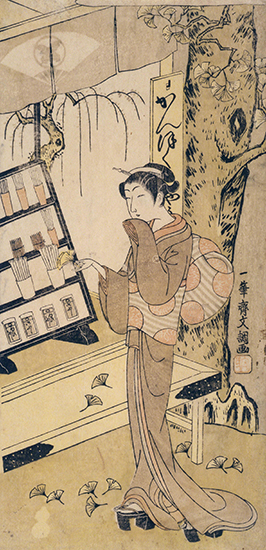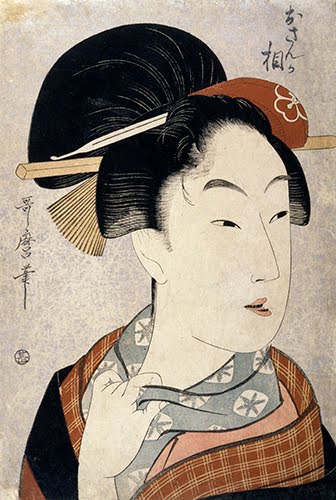"Hmm, Ginko Leaf or Toothbrush?"
I just got a crown on a tooth this week, so I thought I’d do a teeth-themed posting. Goodness knows I don’t love going to the dentist, but he’s a really good one, so I’m no longer “white knuckles in the chair.” They also don’t have to mark “Runner!” in fire engine red on my file.
While I was lounging in the chair waiting to be freed, I contemplated the history of dental care in art. I decided to skip Medieval German treatises “On the Pain of Teeth,” in favor of lighter subjects. Because autumn is just around the corner, I chose this print of a young woman comparing the shape of fallen ginko leaves to the toothbrush used at the time in the Edo Period (1615–1868). It’s so clever!
 |
| Ippitsusai Bunchō (1725–1794, Japan), The Toothbrush Shop Yanagi-ya, ca. 1770. Color woodcut print on paper, 12" x 5 7/8" (30.4 x 14.9 cm). © 2018 Brooklyn Museum. (BMA-1089) |
If you ever wondered how people used to clean their teeth before toothbrushes, there are websites about that. Between 1498 and 1600, the Chinese started using brushes of pig hair glued to bone or bamboo handles. In India, people cleaned their teeth with sharpened sticks since ancient times. This apparently caught on in Japan, but, of course, they refined it. By the time of the Edo period, the Japanese were using the fusayoji and the tsumayoji for oral hygiene. The fusayojiis the closest thing to a toothbrush, I think: it’s a thin willow tree/shrub branch that has been tufted on the end. This treatment was combined with the trsumayoji, a toothpick made from the same tree. Shops that sold toothbrushes were called yojiya (willow shops).
In this print, the young woman curiously compares the shape of the ginkgo leaf with the fusayoji displayed on the top and third shelves. The second shelf contains the tsumayoji. The bottom shelf contains tooth powders (bosuna), the first of which were developed during the first quarter of the 1600s.
Like many of the ukiyo-e artists, the life of Ippitsusai Bunchō (1725–1794) is relatively unknown. He is believed to have trained with a minor master Ishikawa Yukimoto (dates unknown). His earliest works appear in the 1750s, mostly courtesan and actor prints. In actor prints, however, Bunchō is thought to have pioneered—along with the artist Katsukawa Shunshō (1726–1793)—actor prints that were actual portraits rather than stereotypes. He also collaborated with major ukiyo-e artist Suzuki Harunobu (1725–1770).
Bunchō’s style is obviously influenced by both Harunobu and Shunshō, although his figures of both men and women are on the slight side, whereas Shunshō’s are tall. Since I’m not an expert, I would easily have mistaken this print for Harunobu, particularly because of the detailed background illustration, a hallmark of Harunobu’s prints. But I’ve seen other prints by Bunchō where his figures’ proportions are out of whack, which I’ve never seen in Harunobu.
The print below brings up another topic that is bound to come up when discussing dental hygiene in the Edo period: the tradition of Ohaguro (literally “black teeth”) or teeth-blackening.
 |
| Kitagawa Utamaro (1753–1806, Japan), Portrait of an Escort as the Heroine “Osan” from the play “The Almanac-Maker’s Tale,” from the series Four Busts of Dramatic Heroines, ca. 1798. Color woodcut print with mica on paper, 14 ¾" x 9 13/16" (37.5 x 24.9 cm). © 2018 Philadelphia Museum of Art. (PMA-1411) |
The tradition of teeth blackening began to flourish during the Heian Period (794–1185 CE) in Japan among members of the nobility. The practice was widely used by married women of all classes as a sign of health and wellbeing, because it was believed that blackening the teeth prevented decay. The process is practiced to the present day in some rural areas of China and Southeast Asia. It was outlawed in Japan in 1870. Iron filings soaked in vinegar oxidized, turning the vinegar black. This was sometimes added to tea where the tannins helped make it a dye. It was applied to the teeth with a tufted bamboo brush.
I’ve read many theories about why this was considered attractive, though I find it a bit creepy. One theory is that since women in the Heian period began to use extremely white makeup (as one sees nowadays on geisha), which made their teeth appear yellow, they chose to blacken their teeth. I have also read that gleaming white teeth were considered vulgar (before contact with the West). I remember a line from Murasaki Shikibu’s (973–1031) novel Tale of Genji where the prince (Genji) is staring at one of his many sons and remarks “his teeth were charmingly brown.”
During the Edo period, ohaguro was practiced mainly by samurai, women of a certain age (over eighteen), and by geisha and courtesans. The woman depicted in this Utamaro print is from a series in which Utamaro executed portraits of famous courtesans in the roles of famous Kabuki plays. Osan was the wife of an almanac-maker. Her husband’s frequent absences made her yearn for a lover, or, in another twist, to punish her husband who is cheating with her maid Tama. Either way, it ends badly. The play was extremely popular during the Edo period, and was written by Chikamatsu Manzaemon (1623–1724).
Correlations to Davis programs: Experience Printmaking: Chapter 4, art history; The Visual Experience: 3.5, 13.5; Discovering Art History 4E: 2.3, 4.1; Discovering Art History Digital:2.2, 4.1


Comments